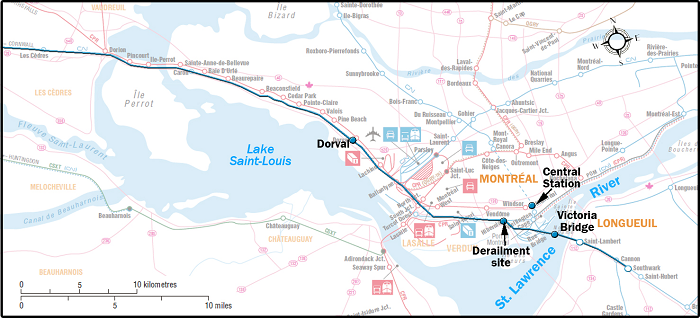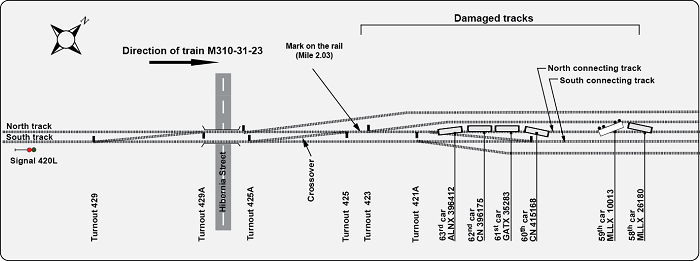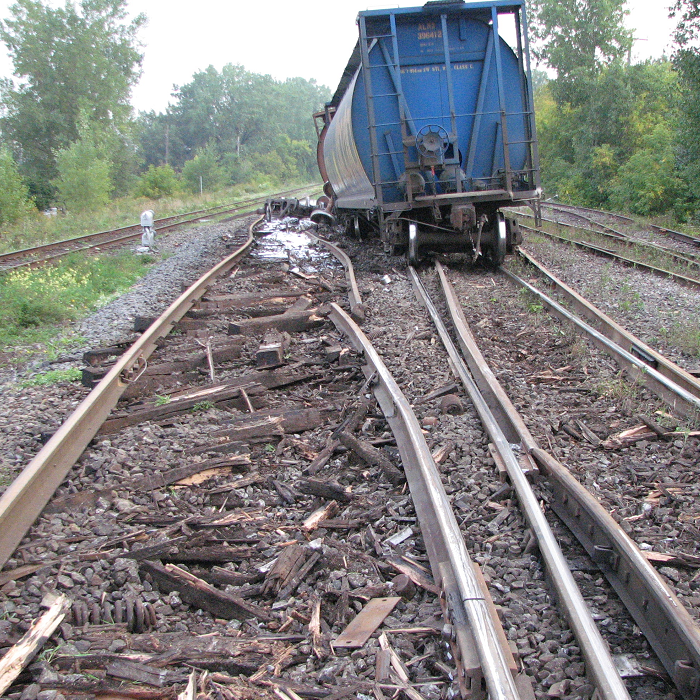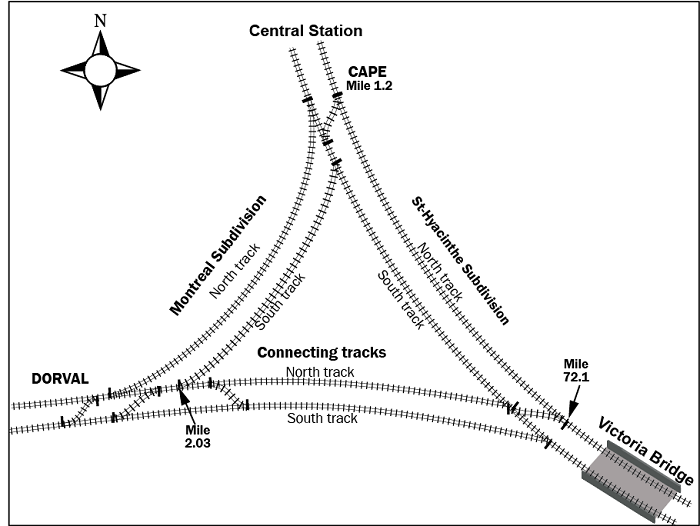Main-track derailment
Canadian National Railway
Freight train M310-31-23
Mile 2.03, Montreal Subdivision
Near Pointe-Saint-Charles, Quebec
The Transportation Safety Board of Canada (TSB) investigated this occurrence for the purpose of advancing transportation safety. It is not the function of the Board to assign fault or determine civil or criminal liability. This report is not created for use in the context of legal, disciplinary or other proceedings. See Ownership and use of content. Masculine pronouns and position titles may be used to signify all genders to comply with the Canadian Transportation Accident Investigation and Safety Board Act (S.C. 1989, c. 3).
Summary
On 24 September 2011, at approximately 0316 Eastern Daylight Time, Canadian National Railway train M310-31-23 derailed 6 cars at Mile 2.03 of the Montreal Subdivision, near Pointe-Saint-Charles, Quebec. A number of turnouts and about 650 feet of track were damaged. No one was injured in the accident, and there were no spills of hazardous material.
Ce rapport est également disponible en français.
Factual information
The accident
On 24 September 2011, Canadian National Railway (CN) freight train M310-31-23 (the train) was travelling eastward on the south track of the Montreal Subdivision (Figure 1). The train comprised 2 locomotives and 91 cars (56 loads and 35 empties). It weighed approximately 8400 tons and measured some 5800 feet in length.
The crew consisted of a locomotive engineer and a conductor. They were qualified for their respective positions and met fitness and rest standards.
At 0314:40,Footnote 1 the train was travelling at 27 mph and entered crossover 425–425A to take the connecting track north toward Victoria Bridge. Following an application of the dynamic brakes, the train's speed dropped to 24 mph when a train-initiated undesired emergency brake application occurred. After taking emergency measures, it was observed that 6 cars (58th to 63rd cars) had derailed.
The sky was cloudy and the temperature was 18°C.
Site examination
The cars derailed to the east of the crossover that connects the south and north connecting tracks through turnouts 425 and 425A. Immediately to the east of turnout 425 (Figure 2), at Mile 2.03, a 7-foot-long mark was observed on the north rail of the south track.
The first signs of damage to the track coincided with the end of this mark, and the damage extended toward the derailed cars. No wheel marks or dragging equipment marks were observed west of turnout 425.
The structures of both the south main track and the north connecting track were destroyed over a distance of approximately 325 feet (Photo 1). Up to the first derailed car, or 300 feet further east, the north rail of the north connecting track was displaced laterally and had rolled over. Dwarf signals and a number of components of turnouts 423 and 421A, including operating mechanisms, were damaged or destroyed.
The derailed rolling stock included 2 covered hopper cars carrying propylene, 1 empty box car, 1 tank car with residue and 2 covered hopper cars carrying wheat.
The 58th car, MLLX 26180, which was the first car to derail, came to a stop on the north connecting track, 660 feet east of the mark observed on the rail near turnout 425. Its trailing truck separated from the car and stayed near turnout 421, or approximately 425 feet further west. The 59th car, MLLX 10013, lost its 2 trucks and turned onto its side. Its hopper doors were damaged, resulting in propylene leaks.
The last 4 derailed cars separated from the train and were located 140 feet from car MLLX 10013. They remained upright and blocked the adjacent tracks. The 60th car, CN 415168, lost its front truck and came to a stop on the south connecting track. The 61st car, GATX 35283, which previously contained aviation fuel (UN 1863), remained coupled to the preceding car and to the last 2 derailed cars. All of the derailed equipment was examined; no pre-derailment defects were found.
During the trip from Toronto, Ontario, the train passed by several wayside inspection systems, the last one located at Mile 4.8 of the Montreal Subdivision, without setting off any alarms.
Particulars of the track
The track consisted of 132-pound jointed rail laid on double-shouldered tie plates, secured to the ties with 4 spikes. There were approximately 3200 hardwood ties per mile of track. The rail was box-anchored every third tie. The ballast, which consisted primarily of crushed rock, showed some signs of patching, but was generally in good condition. The cribs were full, and the shoulders were at least 18 inches in width.
In the accident area, the tracks, including the crossover, were inspected in accordance with the Railway Track Safety Rules (TSR). No flaws were noted during the most recent visual inspections, or during the inspections by the track geometry car and the rail test car. The last regular inspection, conducted with the hi-rail vehicle on 23 September 2011, revealed no defects. The turnouts were inspected monthly, and the last inspection, conducted on 20 September 2011, revealed no defects.
Track information
The Montreal Subdivision consists of double main track that runs from Cape (junction with the St-Hyacinthe Subdivision) at Mile 1.2 near Central Station in Montréal, Quebec, to Dorval, Quebec, at Mile 11.6. The north and south connecting tracks allow trains to travel from the Montreal Subdivision to the St-Hyacinthe Subdivision while avoiding the junction at Cape. They cover a distance of 1.18 miles, from Mile 2.03 of the Montreal Subdivision to Mile 72.12 of the St Hyacinthe Subdivision (Figure 3).
Train movements are governed by the Centralized Traffic Control (CTC) system, as authorized by the Canadian Rail Operating Rules (CROR), and supervised by a rail traffic controller (RTC) in Montréal. Traffic consists of approximately 40 trains a day, which represents an annual tonnage of some 72 million gross ton-miles.
According to the CN timetable, the allowable speed is 15 mph for freight trains between Mile 1.2 and Mile 2.1, and 30 mph between Mile 2.1 and Mile 3.6. On the north and south connecting tracks, the maximum allowable speed is 20 mph. However, the timetable indicates a speed restriction of 15 mph on crossovers and turnouts between Mile 1.2 and Mile 3.6. The operating speed on crossovers is generally dictated by signal indications and depends on the turnout number and type. In comparison, between Belleville, Ontario, and Montréal, most turnouts being number 20 turnouts, the operating speed may reach 45 mph.
Recorded information
Table 1 lists the events that correspond to the data recorded with the lead locomotive event recorder and those of the rail traffic control system.
| Time | Dynamic braking | Speed (mph) | Event |
|---|---|---|---|
| 0236:04 | RTC controls turnouts for the movement | ||
| 0314:30 | OFF | 27 | Locomotive at crossover 425 – 425A |
| 0314:35 | Set | 27 | |
| 0314:40 | DB1 | 27 | Locomotive at turnout 423 |
| 0314:50 | DB3 | 27 | Locomotive at turnout 421A |
| 0314:56 | DB1 | 26 | |
| 0314:57 | DB2 | 27 | |
| 0314:58 | DB3 | 27 | |
| 0314:59 | DB6 | 27 | |
| 0315:00 | DB8 | 27 | |
| 0316:39 | DB1 | 24 | |
| 0316:40 | DB3 | 24 | Loss of segment 421 on control centre panel |
| 0316:43 | DB3 | 24 | Undesired emergency brake application |
| 0316:48 | 21 | Loss of segment 426 on control centre panel | |
| 0316:53 | 13 | Loss of segment 424 on control centre panel | |
| 0317:04 | 0 | Train comes to a complete stop |
Signal indications
The route that the train was to take to Victoria Bridge was set and recorded in the rail traffic control system approximately 40 minutes before the train's arrival. With this route, which indicated no conflicting movements, the train was to take the south track on the Montreal Subdivision, the crossover and the north connecting track, heading toward the St-Hyacinthe Subdivision and Victoria Bridge. This is why the RTC issued the following directions for turnouts 429, 425, 423, 421 and 311Footnote 2:
- turnout 429: normal position
- turnouts 425 and 425A: normal positionFootnote 3
- turnout 423: reverse positionFootnote 4
- turnout 421A: normal position
- turnout 311: reverse position
According to the MO-RA-14 signal plan and the circuit design for this sort of turnout arrangement, dwarf signal 420L, which controls the route established for the train, can give the following indications:
- Medium to clear (green-over-red): proceed at medium speed passing signal and through turnouts.
- Medium to stop (yellow-over-red): proceed at medium speed passing signal and through turnouts, preparing to stop at the next signal.
- Restricted speed (red-over-yellow): permits stopping not only within one-half the range of vision of equipment, but also short of a switch not properly lined, and in no case exceeding slow speed.
The indication displayed also depends on signals that control the crossing for the lead track to the VIA Rail Canada Inc. (VIA) maintenance centre, as well as occupancy of turnout 406 (signals 406L and 312RG).
According to the crew, signal 420L was displaying mediumFootnote 5 to clear (green-over-red).
Crew
The crew members had come on duty in Belleville at around 2200 on 23 September 2011. The engineer had worked on train M310-31-20 on 21 September, between 0540 and 1630. The next day, his shift was on train X371-21-22, between 0345 and 1220. The train conductor was returning to work from a number of days off.
The locomotive engineer had over 34 years of experience, while the train conductor had 27 years of experience. The crew was accustomed to operating trains between Belleville and Taschereau Yard (Mile 8.9 of the Montreal Subdivision) or to Turcot West (Mile 6.2 of the Montreal Subdivision). However, for the past few months, the crew change location had been modified; the team was required to take the train from Belleville to Southwark Yard, located beyond Victoria Bridge at Mile 68.1 of the St-Hyacinthe Subdivision. However, the route used never required passing through a crossover in the derailment zone.
Effects of alertness on performance
The circadian clock is synchronized to the traditional pattern of daytime wakefulness and nighttime sleep. Humans experience 2 periods of maximum drowsiness in every 24-hour period. The times can vary from one person to another, but the principal drowsiness period generally occurs between 0300 and 0500, and the secondary drowsiness period occurs between 1500 and 1700. During these periods of drowsiness, the activity of the physiological systems of the human body are at their lowest level. Irrespective of motivation and circumstances, a person may have a hard time remaining alert during periods of maximum drowsiness.
Many circadian rhythms are interdependent and synchronized to each other as well as to the time of day. Circadian rhythms can become desynchronized due to changes in the sleep-wake cycle. Desynchronization can cause fatigue, sleepiness, impaired performance, reduced cognitive abilities and more. Employees working shifts with variable start and end times are more susceptible to being affected by this type of desynchronization.Footnote 6
Effect of excessive speed and dynamic braking
The L/V ratio is the ratio between the lateral forces (L) that push the rail outward and the vertical forces (V) that push the rail downward. The tendency for the rail to overturn or shift outward, or for the wheel to lift, increases as the L/V ratio increases. The change in angle when moving through a crossover and the absence of banking at the exit of turnouts are factors that can affect this ratio. The application of dynamic brakes when approaching crossovers, turnouts and sharp curves can also generate longitudinal and lateral forces, thus affecting the L/V ratio.
The use of dynamic braking is part of the basic training of locomotive engineers. Sections G2.12 and G2.13 of CN's General Operating Instructions, which deals with train operations, provide details on the braking force generated by dynamic brakes according to speed. They indicate, among other things, that the retarding force is at its maximum when the train is running at speeds from 5 to 30 mph and provide a few key points to respect when using dynamic brakes. Furthermore, these instructions indicate that the locomotive engineer must be extra careful when using dynamic braking to reduce the forces generated as the train is approaching crossovers, turnouts and sharp curves, because they can damage the track or produce excessive force on the train and cause a derailment.
Analysis
No defects were identified in the rolling stock or the track that could be considered a contributing factor in this incident. In this case, the train's speed exceeded the authorized speed for crossovers; as a result, the analysis will focus on subdivision familiarization and signalling, as well as on the risks associated with operator alertness.
The accident
Most derailments that occur in curves, turnouts or crossovers are due to the increase in lateral loads generated by excessive speed. At these same locations, sudden braking also increases the lateral forces and therefore the risk of derailment.
The mark observed on top of the north rail suggests that the derailment occurred after a wheel lifted. This lifting was the result of a sudden increase in the L/V ratio caused by the increase in lateral loads and the reduction in vertical loads of the wheel. When the train's locomotive entered the north connecting track, shortly after passing through turnout 421A, the train was travelling at 27 mph, while the authorized speed was 15 mph. The dynamic brakes were then applied quickly to reduce the speed, going from DB1 to DB8 in 4 seconds. This sudden application of the brakes generated a compression wave that moved toward the back of the consist, reaching the 58th and 59th cars when these were passing over turnout 423. Since the retarding force of the dynamic brakes was at its maximum at the speed at which the train was moving, its effect, combined with that of the excessive speed, resulted in a sudden increase of the lateral forces acting on these 2 cars, causing the back wheel of the 58th car to lift, and the train to derail.
Subdivision familiarization
While the crew members were qualified and experienced, they had only recently been assigned to this territory. When qualified locomotive engineers have not worked in a particular part of a subdivision for an extended period of time, or if they work there sporadically, they may not be able to fully use geographical landmarks in the area to assist them in their duties. It is also possible that the information for the safe operation of trains, such as the timetable instructions or special instructions, may not be completely integrated. In such cases, the crew members must rely on operating timetables and other information to guide their actions. If this does not occur, the risk that the locomotive engineers make inappropriate decisions increases, and accidents may occur.
Speed
While operating speeds, as well as the zones in which they are applied, were specified in the current timetable, the train exceeded the speed allowed. According to the timetable in effect, the speed was 15 mph between Mile 1.2 and Mile 2.1, and 30 mph between Mile 2.1 and Mile 3.6. However, the authorized speed was 15 mph when moving through crossovers and turnouts, unless otherwise provided by signal indication. Furthermore, the authorized speed was 20 mph on the connecting tracks. Although multiple speed limits are common throughout the system, the crew's limited knowledge of and experience on this territory likely affected their decisions regarding speeds. As a result, the train passed the interlocking limit at a speed faster than what was allowed.
Signalling
The route to Victoria Bridge was set and recorded in the rail traffic control system, and the turnouts in question were lined accordingly, well before the train's arrival. Since there was no conflicting movement, according to the design of the turnout circuits for this route, signal 420L should indicate medium to clear (green-over-red) or medium to stop (yellow-over-red), depending on the occupancy of the railway crossing for the lead track to the VIA maintenance centre. In both cases, the signalling system would authorize the train to proceed at medium speed, or 30 mph, on the crossover, while the timetable indicated a maximum speed of 15 mph. This ambiguity between the signal indication and the timetable instructions regarding permitted speeds may result in inaccurate interpretations and thereby increase the risk of accidents.
During the few months the crew was assigned to this section of the territory, their train ran on the same track to Victoria Bridge. As a result, the crew had not experienced moving through a crossover in the derailment zone. Given these circumstances and the crew members' experience (essentially on the Kingston Subdivision), the "medium speed" indication given by the signal reinforced their mental model. Therefore, they operated the train as they were accustomed to doing in their old territory, and, as a result, the train exceeded the speed allowed through the crossover.
Effects of alertness on performance
The conductor was completing his first night shift after several days off and was susceptible to desynchronized circadian rhythms. During the week of the accident, the locomotive engineer began his shifts at different times of day, and he was therefore more likely to be affected by desynchronized circadian rhythms. Furthermore, the derailment occurred more than 5 hours after the beginning of the shift, during a time of night when drowsiness and decreased alertness often occur. The detection of signals along the track right-of-way and the reaction to these, as well as compliance with the timetable instructions, require cognitive functions such as alertness, attention and the ability to react to stimuli. These functions become even more important when a train crew is not very familiar with a territory as complex as the tracks leading to Victoria Bridge. These cognitive functions may be disrupted by drowsiness and reduced alertness associated with the desynchronization of circadian rhythms.
Crews that work variable, unpredictable schedules like that of the locomotive engineer in question are exposed to an increased risk of diminished alertness associated with the desynchronization of circadian rhythms.
Findings
Findings as to causes and contributing factors
- The train derailed when an excessive lateral force due to overspeed, as well as the sudden application of dynamic brakes, caused the wheel of the 58th car to lift.
- While operating speeds and the zones in which they apply were specified in the current timetable, the train exceeded the authorized speed.
- The different indicated speed limits and the limited knowledge of and experience on this territory likely affected the crew's decisions about speeds and, as a result, the train passed the interlocking limits faster than authorized.
- Given the experience of the crew members, the "medium speed" indication given by the signal reinforced their mental model, and they therefore operated the train as they were accustomed to doing in their previous territory. As a result, the speed limit was exceeded through the crossover.
Findings as to risk
- When qualified locomotive engineers have not worked in part of a subdivision for a long time, or when they work there sporadically, and do not fully utilize available operating instructions, the risk that they will make inappropriate decisions increases, which can lead to accidents.
- The ambiguity between signal indications and instructions in the timetable with regard to authorized speeds can result in inaccurate interpretations, and can consequently increase the risk of accidents.
- Crews that work variable, unpredictable schedules are exposed to an increased risk of diminished alertness associated with the desynchronization of their circadian rhythms.
This report concludes the Transportation Safety Board's investigation into this occurrence. Consequently, the Board authorized the release of this report on . It was officially released on 16 November 2012.



